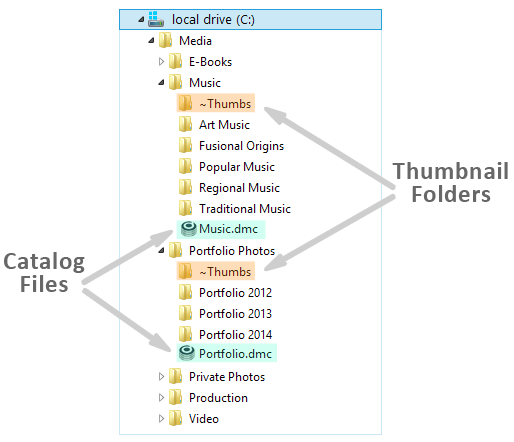So that you can find documents quickly, Daminion stores all information about imported files in a database called a catalog. Some of the information, mainly technical data, is imported automatically from asset metadata; however, most of the descriptive information must be entered manually by the user.
Daminion gives you the flexibility to create and manage multiple catalogs and open them on different page tabs. Catalogs do not store the original files – they store only links to the files.

Local and Shared Catalogs
Daminion supports two types of catalogs: “local catalogs” and “shared catalogs”.
A local catalog is a single file (an SQLite database) with a .dmc extension. You can open and manage several catalogs at once but only on one computer. The catalog cannot be accessed from a second computer via a network. It is an effective and fast single solution for anyone who works independently on a local computer with no need to share catalog data with others. To work with local catalogs you need only the Daminion Standalone version.
Shared catalogs allow multiple users to access the same asset archives collaboratively and safely through a company’s local network. The Daminion Server is required in order to create and work with shared catalogs. The Daminion Standalone version is used as the client to access the Daminion Server.
Daminion Server uses the enterprise-level PostgreSQL database engine, which can protect shared catalogs by restricting user access to particular files and functions.
Support for Multiple Catalogs
Digital assets in different formats or based on different themes can be separated into individual catalogs. For example, private_photos.dmc can be used for private photos; music.dmc for songs; landscapedesign.dmc for a collection of landscape designs, etc.
Multiple departments of a company can each use multiple shared catalogs for their own needs.
Portable Local Catalogs
Daminion stores relative links to imported files in local catalogs. This means that you can easily move your photo archive library to a new location simply by copying the folder that contains all the photos and the .dmc catalog file. For example, to move “D:\Media\Photos” to “E:\Photos”. Daminion will correctly see the files, even though the folder has been moved to a new location.
The only requirement is that the catalog’s .dmc file should be stored in the same folder as the imported files. This folder will also contain thumbnails and version folders that can easily be backed up.

Another benefit of relative paths is that they allow you to create portable catalogs on external drives and devices even if your Windows drive letters have a tendency to change each time a device is plugged into your computer.
Keep a note of the following when working with your cataloged media
- Storing local catalogs in network locations may damage your data. The Daminion Server is required if you need to provide access to your digital media archive across a local network
- Daminion supports working with offline files. You can search, organize, and maintain catalogs even if your original files are not present. The thumbnails and information associated with these files can still be viewed in the catalog.
- As the original files are not embedded in the catalog, Daminion cannot display them in larger files if the original files are missing or offline.
- You cannot recover files from the Daminion catalog if you delete these files from the disk outside Daminion. A catalog contains only information about the file, not the file itself.
- Adding files to the Daminion catalog will not move or modify the original media files.
Cataloging strategies
Because Daminion can manage more than one catalog at once, it is entirely up to you to decide how many catalogs you want to create and whether or not you separate your media files into several catalogs. You could, for example, create one catalog for your image files, one for your documents, and one for your video files. If you wanted, you could even import all your different media files into one large catalog. It makes no difference because Daminion has all the features you need to easily manage large – even huge – amounts of data stored in one catalog. Daminion can create and handle multiple catalogs, both local and shared.